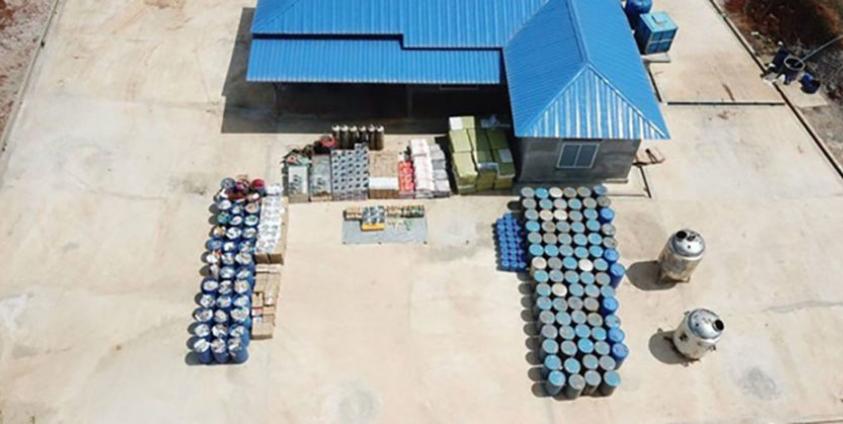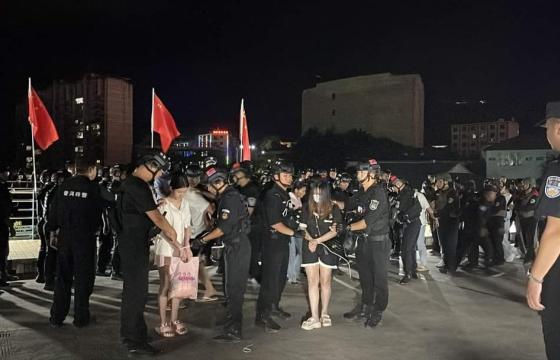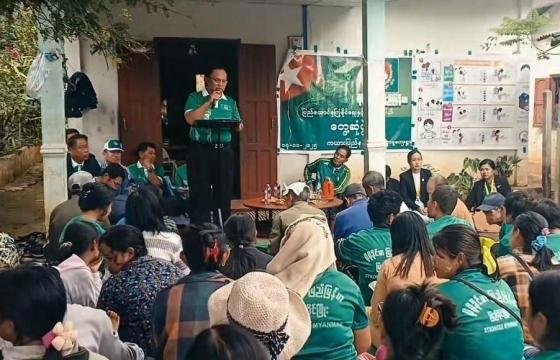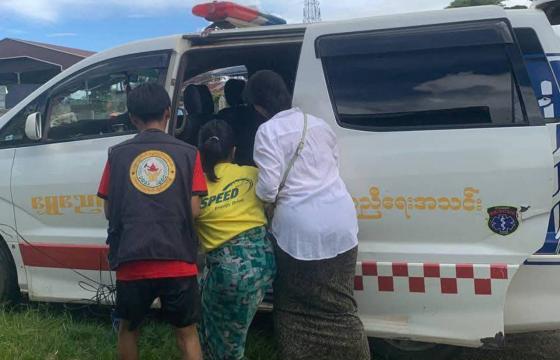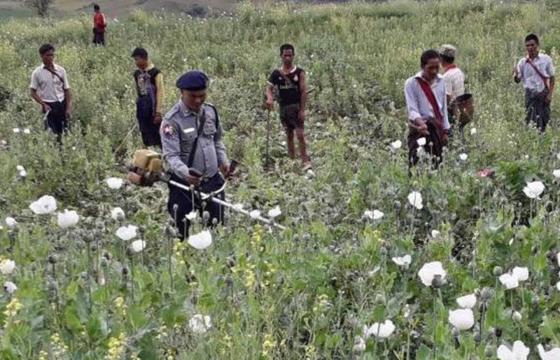Sai Wansai — When the Tatmadaw or Burma army recently announced the large amount seizure of narcotics in Kutkai Township, Kaungkha village, later followed by the disarmament of Kaungkha people’s militia, observers and Burma or Myanmar watchers were at a lost as to why all of a sudden it resorted to such drastic actions, which it has turned a blind eye for so long. Moreover, experts scrambled to speculate on what its aims could really be or what it actually has in store.
On April 7, the Tatmadaw issued a statement of its seizure of 412 billion kyat (US$288.44 million) worth of illegal drugs in Kutkai township in Shan State in the past 40 days. The anti-drug operation, which started on February 28, centered on two suspected drug manufacturing facilities in Lwekham village in Kutkai.
According to the Myanmar Police Force Central Committee for Drug Abuse Control, 286.64 billion kyat worth of narcotic drugs and chemicals were seized in Shan State in 2018, and 282.53 billion kyat worth were seized in 2019, wrote the Myanmar Times report of April 8.
Also earlier on April 1, Tatmadaw publicized that it seized 48 billion kyat worth of 20 million tablets of amphetamine, heroine and drug precursors. With earlier seizure of some 400 billion kyat worth of narcotics and drug precursors, it all adds up to 280 million US dollar, which is taken as the highest amount of seizure in a particular geographical area, reported the Voice of America on April 6.
On March 26, Myanmar’s 99th Light Infantry Battalion invaded the Kaungkha militia headquarters in Lwekham village and disarmed the outfit, where not less than 1000 weapons were sized.
The reason for the undertaking is that Kaungkha militia is suspected to be involved in drug trafficking and being handled according to the law, said the Tatmadaw’s spokesman Brigadier General Zaw Min Tun to the media.
He said drug manufacturers, users, and those who fail to notify authorities about illegal drug activities can be prosecuted under Myanmar’s Narcotic Drugs and Psychotropic Substances Law. Furthermore, he pointed out that without the involvement of the people who bear arms such activities would be impossible to undertake and that is why actions have to be taken.
“Those who have breached the anti-narcotics law will be taken care of accordingly and those failing to report of which it is their duty prescribed under the law will be punished,” said Zaw Min Tun.
Reportedly ten of the Kaungkha militia leaders which were under investigation in North Eastern Military Command Lashio, were all freed except for two or three, according to one militia man who refused to be named.
The Tatmadaw spokesman regarding the militia’s disarmament said: “Concerning the real reason behind the disarmament, explanation were given to responsible people at a meeting during this week. After the reality and truth were explained Kaungkha militiamen who are also not keen to hold on to their weapons for long from the outset, including the Tatmadaw’s urging, surrendered their arms.”
Meanwhile, regarding the future of the disbanded militia he said: “I would like to say that after the turning in of the weapons (surrender) concerning the rehabilitation the Tatmadaw will monthly arranged the support of 550 rice sacks, 580 peittha (1 peittha = 1.6kg) of edible oil and 50 sacks of yellow lentils for the militia’s families. Besides, arrangement has been made to give necessary loans without interest, including other helps, if they want to do official business like agriculture and animal husbandry.”
However, while the Tatmadaw’s offer was real, it was shot down by the militia, as a third rank officer Zaw Long said: “We already have business companies and have businesses owned by the group (militia). These will continue to function regularly. We have mining enterprise and export import companies.”
“Now we don’t need to take care of the (area) security, so we can wholeheartedly be engaged in business,” he added.
The militia group originated from Kachin Independence Army (KIA) Brigade 4, which in 1991 signed ceasefire with the government and became Kachin Defense Army (KDA). Later in 2008 it changed to Kaungkha, with five controlled areas in Kutkai Township. Officially it has 850 soldiers and more than 2,000 reservists not registered with the Myanmar government, as well as liaison offices in five townships in northern Shan State.
While it is a puzzle as to why the Tatmadaw has waited so long to come down on Kaungkha militia when it always has easy access to enter its areas to take actions in involvement in drugs trafficking, which has been notoriously known all along ever since the early 1990s ceasefire time, the motive, according to experts, could be to undercut the Arakan Army’s (AA) financial resources, believed to have come from the sales of narcotics.
It is now evident that the Tatmadaw is reactivating its notorious “four cuts” counter-insurgency strategy that aims to cut off food, funds, intelligence and popular support of the AA. And in the process cutting financial life line by disarming and disbanding Kaungkha militia which is part and parcel of the whole game plan, including declaring the AA a terrorist organization and making use of the counter-terrorist act to easily crackdown on those who may be sympathizers and backers of any kind.
Kaungkha militia heavy involvement in drugs is well known and was quite explicitly mentioned in a story filed by the Reuters titled, “Special report: The hunt for Asia’s El Chapo,” on October 14, 2019.
The report said that the epicenter of meth production had shifted from China’s southern provinces to Shan State in Myanmar’s northeastern borderlands, which the International Crisis Group (ICG) also reported earlier in January 2019.
“The Kaungkha militia’s immaculate and expansive new headquarters sits on a plateau nestled between the steep green hills of the jagged Loi Sam Sip range. About six kilometers away, near Lwekham village, was a sprawling drug facility carved out of thick forest. Police and locals say the complex churned out vast quantities of crystal meth, heroin, ketamine and yaba tablets – a cheaper form of meth that is mixed with caffeine,” wrote the report.
According to it Lwekham facility, operated by Kaungkha militia, was “very likely” to have been the source of much of the Sam Gor syndicate’s meth, said the Yangon-based AFP (Australian Federal Police) officer.
Sam Gor in Cantonese means “Brother Number Three,” whose real name is Tse Chi Lop, a Canadian national born in China, is suspected of leading a vast multinational drug trafficking syndicate formed out of an alliance of five of Asia’s triad groups, according to law enforcement officials. He is also dubbed “Asia’s El Chapo” by the media.
In the same vein, Tatmadaw might have speculated and concluded that AA’s ability to raise massive fund must be somehow connected to Kaungkha, one way or the other. Besides, it is driving for the acceptance of its hypothesis that AA is indeed a terrorist group and is deeply involved in money launder and terrorist financing. It seems to be hoping that this would help solicit international cooperation and aids in its quest to get rid of the AA.
Indeed, apart from seizure of drugs and precursors, some 1000 brand new weapons surrendered by Kaungkha militia which could arm about six military companies showed that it is also involved in gun-running.
Furthermore, the militia’s area of operation is adjacent or overlapped with the Kokang or Myanmar National Democratic Alliance Army (MNDAA) and Ta’ang National Liberation Army (TNLA) operational areas but no armed clashes have been reported between them in all these years. Thus, a suspicion that the Kaungkha militia might be also supplying arms to the two ethnic armed organizations becomes more plausible, even if there is no concrete evidence.
In addition, to the dismay of the Tatmadaw, AA has been delivering serious military blows to its troops on the ground, according to its own account.
The Tatmadaw’s various press conference and statements included: the AA repeated attacks on its military convoys; attack of a Tatmadaw’s military training school; and circling and attacking of strategic hill tops, employing hundreds of AA soldiers. Reportedly, the Tatmadaw also employed combat helicopters, fighter bombers and even navy warships to counter the AA.
In one episode, Tatmadaw’s combat helicopters transporting dozens of troops for reinforcement to rescue the surrounded troops on a strategic hill top were all captured by the AA, including a company commander.
Thus, the two announcements 1/2020, dated March 23, of the Ministry of Home Affairs and Anti-Terrorism Central Committee which included Declaration of Unlawful Association and Declaration of Terrorist Group made respectively directing solely at the AA; Tatmadaw’s ultimatum at the end of March to evict AA troops from KIA-controlled territory and cut ties with it or face attack; and finally trying to cut the financial resources and armament of AA by disbanding the Kaungkha militia are all linked, which seems to be the holistic Tatmadaw’s plan to defeat the AA.
For now the civilians have to endure the brunt of the fighting, resulting in thousands of internally displaced persons, dozens of civilian killed in crossfires and hundreds imprisoned for suspicion of being insurgents, which continues unabated. And it is not even sure, if the Tatmadaw’s head-on total war strategy will work to its advantage and end the war forcefully.
But a more logical and sane approach will be to accept the UN Secretary-General António Guterres’ ceasefire call the world over, which most political parties, ethnic armed organizations, civil society organizations and many western ambassadors within the country, including nearly 60 countries, have endorsed, in order to combat coronavirus epidemic that is threatening the existence of the whole mankind.


